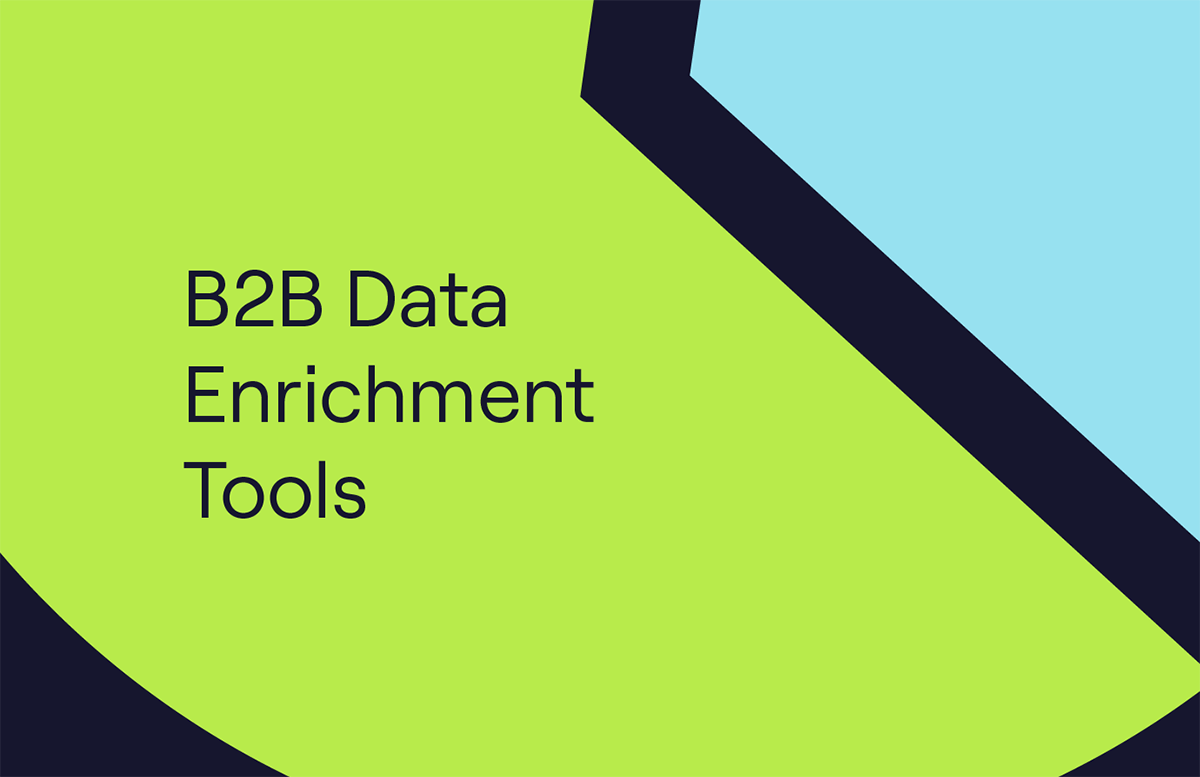Comprehensive Data Management & Key Trends For 2026
What’s happening if your sales reps call the wrong phone numbers, your marketing emails bounce, or your analytics can’t connect activities to results?
The answer is - you’re facing a data management problem. And you’re not alone. By 2027, 80% of data and analytics governance initiatives will fail due to a real or manufactured crisis (e.g. lack of alignment with business outcomes) (Gartner).
This blog will provide practical solutions to transform your B2B data from an overwhelming liability into a revenue-driving asset.
Master data management today - scroll 👇 for insights!
2025 data management trends & modern architectures
With AI-adoption being one of the first topics on every CEO’s mind, the data landscape is evolving rapidly. The future of GTM is automation and AI, but you can’t unlock the value of either without clean, accurate, and composable data at scale.
This fact drives two trends reshaping how businesses collect, process, and activate their information.
Data mesh and autonomous data products
Instead of centralised bottlenecks, organisations are adopting data mesh architectures. These give individual business units ownership of their “data products”. These are trusted, self‑service assets that are discoverable across the enterprise. Tools like Cognism DaaS make delivering clean, compliant datasets easier into these distributed systems.
Data becomes embedded in every job role
Data is no longer the sole responsibility of IT or data teams. With the use of AI agents in its early-adoption phase, the rate of growth will only get faster. Everyone from sales representatives to marketing managers to customer success agents plays a part in maintaining and using the quality data that powers them.
-
Sales teams depend on accurate enrichment for prospecting and pipeline forecasting.
-
Marketers use real‑time firmographics and intent signals to refine targeting.
-
Customer success teams rely on unified interaction histories to reduce churn.
-
Operations and leadership need governed data to measure performance and guide strategy.
This cultural shift means organisations require tools and services that make data management intuitive and seamless.
What is data management?
Data management is the organised approach to effectively collecting, storing, maintaining, and using your business information. It’s about ensuring that your data is accurate, accessible, secure, and valuable throughout your organisation.
For B2B specifically, effective data management:
- Creates a single source of truth for customer and prospect information.
- Establishes governance frameworks for data quality and compliance.
- Implements technologies that make data accessible to the right people.
- Builds business processes to keep information current and accurate.
- Develops methods to transform raw data into actionable insights.
- Ensures security and regulatory compliance across all data activities.
Key business data degrades at 22.5% annually (HubSpot) without proper management, directly undermining your revenue efforts.
What are the key components of a data management strategy?
A comprehensive B2B data management strategy encompasses:
- Data collection: Methods for gathering information from primary and third-party sources.
- Data storage: Database architecture and cloud vs. on-premises decisions.
- Data cleansing: Processes to identify and correct inaccuracies.
- Data enrichment: Adding value through third-party intelligence.
- Data integration: Connecting information across your tech stack.
- Data governance: Policies for handling information responsibly.
- Data analysis: Converting raw data into actionable insights.
- Data security: Protocols to safeguard sensitive information.
While many organisations focus primarily on collection and storage, the most successful revenue teams invest equally in cleansing, enrichment, and integration.
Why does data management matter for GTM teams?
Here’s how effective data management affects each revenue function in your organisation:
Faster deal cycles for sales teams
Sales reps waste an average of 22.75 days each year on inaccurate data.
With robust data management, sales teams can eliminate data inconsistencies, ensuring accurate lead information, precise contact details, and comprehensive customer insights.
This translates directly to faster deal cycles, more targeted outreach, and improved pipeline forecasting.
Highly targeted campaigns for marketing teams
Data management enables precision marketing, i.e. precision targeting and personalised communication.
Without clean, integrated data, marketing efforts become scattershot. Resources are wasted on irrelevant messaging and poorly targeted campaigns.
Comprehensive data management allows marketers to create detailed customer profiles, accurately track buyer journeys, and develop hyper-personalised marketing strategies that resonate with specific audience segments.
Help prevent churn for customer success teams
Customer success teams rely on data to transform reactive support into proactive relationship management.
Fragmented data means missed opportunities, inconsistent customer experiences, and reduced retention potential.
Proper data management creates a 360-degree view of each customer, tracking complete interaction histories, identifying potential churn risks, and enabling personalised engagement strategies.
Data-driven decisions for RevOps teams
Without strong data management, RevOps teams struggle with inefficiencies, misalignment, and poor forecasting.
Clean, unified data helps revenue operations analyse performance, identify trends, and make data-driven decisions that optimise revenue growth.
What are the best practices for B2B data management?
Follow these proven approaches to maximise the value of your B2B data:
1. Establish transparent data governance
Data governance forms the foundation of effective management. It defines who owns, manages, and can access different information types within your organisation.
Define data ownership
Assign specific accountability for different data categories (contacts, accounts, opportunities) to appropriate teams or individuals.
This prevents the “everyone’s responsibility means it’s no one’s responsibility” problem.
Implementation tip
Create a RACI matrix (Responsible, Accountable, Consulted, Informed) for each data type, clearly documenting who makes decisions about field definitions, required values, and quality thresholds.
Create standardised processes
Develop consistent procedures for data entry, updates, and maintenance across departments.
When everyone follows the same protocols, data consistency improves dramatically.
Implementation tip
Document step-by-step workflows for common data actions (adding contacts, updating company information, recording interactions) with screenshots and examples of properly formatted data.
Document data definitions
Establish a shared understanding of each field’s meaning, acceptable values, and how the information will be used.
This eliminates confusion and improves reporting accuracy.
Implementation tip
Create a searchable data dictionary that includes:
- Field definitions.
- Format requirements.
- Example values.
- Business context for why each data point matters.
2. Implement regular data cleansing
Data quality decays naturally over time. Follow these steps to ensure your data remains sound:
Audit your database quarterly
Schedule regular reviews to identify errors, outdated information, and gaps in critical fields.
This prevents the gradual erosion of data quality that undermines your revenue efforts.
Implementation tip
Create data quality scorecards for key data objects (accounts, contacts, opportunities) with metrics like completeness, accuracy, and recency that teams can track over time.
Remove duplicates
Duplicate records skew analytics, waste marketing resources, and create confusion about customer history.
Implement both automated and manual deduplication processes.
Implementation tip
To identify potential duplicates, use fuzzy matching rules based on email domains, company names, and contact information.
Then, have data stewards review and merge records appropriately.
Update contact details proactively
Don’t wait for bounced emails or failed calls to identify outdated information. Implement data management systems (like Cognism!) to refresh contact data automatically.
Implementation tip
Manage your data effectively with Cognism Enrich. It’s the ultimate solution for keeping your CRM data fresh and reliable, supporting:
- Enrichment through the Cognism API automatically.
- On-demand CSV enrichment (upload your CSV, and Cognism will fill in the missing info).
See how Cognism Enrich works - take an interactive tour 👇
3. Enrich with third-party intelligence
First-party data tells only part of the customer story. External enrichment provides crucial context for effective targeting and engagement.
Supplement first-party data
Combine your internally collected information with validated third-party data to create complete customer profiles.
This provides a more comprehensive view of each account.
Implementation tip
Prioritise enrichment fields based on your ideal customer profile criteria.
Focus first on information that directly impacts lead qualification and segmentation.
Add verified contact information
Standard business contact details (switchboard numbers, generic emails) create barriers between your team and decision-makers.
Invest in accurate direct dials, mobile numbers, and personal emails.
Implementation tip
Check out Cognism’s Diamond Data®, a unique data asset comprising phone-verified mobile numbers.
These numbers guarantee you’ll reach up to 87% of your sales list.
Incorporate intent signals
Traditional firmographic data shows who might buy, but intent data reveals who’s actively looking to buy now. Combine both for maximum impact.
Implementation tip
Cognism’s intent data (powered by Bombora) is available in our Elevate pricing package. For more information, visit our pricing page.
4. Centralise your data architecture
Fragmented data creates contradictory views of customer reality. A centralised architecture establishes a single version of truth.
You might want to consider implementing a Data as a Service (DaaS) solution to help you centralise architecture. Cloud-based platforms access and use your data via the Internet on a subscription basis. APIs tap into your data lakes and existing systems, meaning you don't need any additional infrastructure.
Cognism's DaaS, for example, will provide you with a combination of firmographic, technographic, contact data, and buying signals, empowering your team with continually refreshed data.

Establish your CRM as the system of record
Designate one platform as the authoritative source for customer information. Your goal is to eliminate conflicts between systems.
Implementation tip
Document which fields originate in which systems. Ensure you have clear rules for which platform takes precedence when conflicts arise.
Connect key platforms
Ensure marketing automation, sales engagement, customer success, and financial systems share relevant customer data bi-directionally.
Implementation tip
Cognism integrates with the tools you use every day - click 👇 to see our list of integrations.
Create smooth data flows
Implement real-time or near-real-time synchronisation between systems. You want your teams to work with the most current information.
Implementation tip
Audit sync frequencies and error logs monthly.
Identify and resolve integration issues before they impact revenue operations.
5. Prioritise compliance and security
Non-compliant data usage creates significant legal and reputational risks for B2B organisations.
Stay up-to-date with regulatory requirements
The GDPR, CCPA, and country-specific telemarketing regulations create a complex regulatory compliance landscape.
Establish management processes to keep pace with requirements.
Implementation tip
Cognism is a GDPR and CCPA-compliant B2B data provider. It maintains compliance in the following ways:
- It adheres to a stringent data verification process.
- It ensures all its data is legally sourced and of the utmost quality.
- It’s regulated by the ICO and provides users with a notified database.
- It scrubs mobile numbers against Do-Not-Call lists in a record 13 countries: the UK, USA, Australia, Canada, New Zealand, Belgium, Croatia, France, Germany, Ireland, Portugal, Spain, and Sweden.
Establish security protocols
Create appropriate access controls, encryption standards, and handling procedures for sensitive information.
Implementation tip
Implement role-based access controls that limit data visibility based on business need, with special protection for personally identifiable information.
6. Focus on data usability
Even perfectly accurate data provides no value if teams can’t easily access and apply it.
Make data accessible
Create intuitive interfaces and reports that put relevant information at users’ fingertips without requiring technical expertise.
Implementation tip
Build role-specific dashboards and views highlighting the most relevant data for each team member’s function. Try to limit information overload!
Provide contextual information
Raw data points become valuable when teams understand what they mean and how to use them.
Implementation tip
Add field-level help text, tooltips, and usage examples to your CRM and other platforms.
This will help to guide proper interpretation.
Create actionable signals
Transform data into clear next steps for sales and marketing teams through alerts, tasks, and prioritisation frameworks.
Implementation tip
Implement scoring models that combine multiple data points into simple prioritisation signals, with automated task creation when high-value triggers occur.
What are the top data management tools?
The right technology stack makes effective data management possible.
Here are the leading solutions for B2B organisations:
Cognism: DaaS solution for B2B contact data

Cognism’s Data-as-a-Service (DaaS) delivers real-time, structured, compliant B2B contact and firmographic data directly into your GTM stack. It eliminates manual enrichment and bulk credit waste by providing continuously refreshed data through APIs, Snowflake, S3, or BigQuery.
Key benefits:
-
Enterprise-ready compliance with GDPR, CCPA, and PECR.
-
Custom logic, schema mapping, and intent signal integration.
-
Audit-ready metadata and consent trails.
-
Advisory services from dedicated consultants.
-
Structured, deduplicated data at scale.
Best for:
Revenue teams (Sales, Marketing, RevOps) who need clean, compliant data streams for power forecasting, targeting, and reporting.
See what our customers say 👇

CEO @Lead Forensics

Salesforce: CRM with a wide range of integrations
/Competitors%20and%20other%20tools/Still%20to%20approve/Salesforce/salesforce-engagement-marquee.webp?width=500&height=333&name=salesforce-engagement-marquee.webp)
Salesforce is a market-leading CRM providing a 360-degree view of customers, supported by thousands of integrations via its AppExchange. Its Einstein AI capabilities add predictive insights for sales and marketing.
Key benefits:
-
Highly customisable workflows.
-
Scalable for SMBs to enterprises.
-
Rich ecosystem of third-party apps.
-
Strong analytics and reporting features.
Best for:
Organisations looking for an all-in-one CRM to unify sales, marketing, and customer success data.
Segment: A customer data platform (CDP)
/Competitors%20and%20other%20tools/Still%20to%20approve/Segment%20(Twilio)/segment-overview-screen.webp?width=700&height=371&name=segment-overview-screen.webp)
Segment (a Twilio company) unifies customer data from multiple touchpoints, routing it into over 300 connected tools. It simplifies data governance and enables consistent customer experiences across channels.
Key benefits:
-
One API for data collection and distribution.
-
Advanced audience segmentation.
-
Compliance-ready governance features.
-
Real-time data delivery across platforms.
Best for:
Marketing and product teams aiming to build consistent, personalised customer journeys.
Snowflake: Data cloud and marketplace
/Competitors%20and%20other%20tools/Still%20to%20approve/Snowflake/snowflake-dashboard-product-graphic.webp?width=700&height=467&name=snowflake-dashboard-product-graphic.webp)
Snowflake provides a cloud-native data warehouse and marketplace, enabling secure data sharing and consumption. It also supports real-time collaboration across business units and external partners.
Key benefits:
-
Highly scalable data warehouse.
-
Secure data exchange and monetisation options.
-
Supports both structured and semi-structured data.
-
Integration with major BI and analytics tools.
Best for:
Enterprises managing large-scale analytics, data science, and cross-organisational data sharing.
AWS Data Exchange: Data marketplace
/Competitors%20and%20other%20tools/Still%20to%20approve/AWS%20Data%20Exchange/aws-data-exchange-product-graphic.webp?width=700&height=383&name=aws-data-exchange-product-graphic.webp)
AWS Data Exchange allows businesses to find, subscribe to, and use third-party data in the AWS ecosystem. Subscribers can integrate data directly into analytics and AI workflows.
Key benefits:
-
Seamless integration with AWS services.
-
Pay-as-you-go or subscription models.
-
Wide range of industry datasets.
-
Secure, governed access to external data.
Best for:
Enterprises already using AWS infrastructure that need external datasets for analytics and modelling.
💡 You might also like to read our post about data orchestration.
What are the common challenges and solutions in B2B data management?
Even with the right tools and intentions, B2B organisations face significant data management challenges.
Here’s how to overcome them:
Challenge 1: Data decay
B2B data decays at 22.5% annually as people change roles, companies, and contact details, making yesterday’s perfect contact list today’s collection of bounced emails.
The solution?
Invest in continuous verification rather than one-time purchases.
Partner with data enrichment and DaaS providers like Cognism that automatically refresh your data.
Implement regular enrichment cycles for high-value segments, establish quality metrics with automated alerts, and create simple mechanisms for sales teams to flag outdated information during their daily outreach.
Challenge 2: Siloed systems
86% of senior executives agree that eliminating organisational silos is critical to expanding the use of data and analytics in decision-making.
When your marketing, sales and customer success platforms don’t communicate, your entire revenue operation suffers.
To avoid this, establish your CRM as the central source of truth with clear ownership hierarchies.
Connect platforms through integration tools like Segment or Zapier, and ensure changes in one system automatically update across your entire tech stack.
Challenge 3: Compliance complexity
The global patchwork of data regulations creates significant risk.
The GDPR, CCPA, and country-specific rules each have unique requirements for consent, retention, and transparency, with penalties reaching 4% of global revenue.
Protect your organisation by partnering with compliance-focused data providers who handle verification as part of their service.
Document all consent with detailed timestamps and communication preferences.
Create SLAs for handling data subject requests with clear responsibility assignments and response timeframes.
Challenge 4: Adoption resistance
Even perfect systems fail when teams resist using them.
Sales representatives often view data management as administrative overhead, leading to incomplete updates, neglected spreadsheets, and inconsistent practices.
Overcome this resistance by demonstrating how quality data directly drives sales KPIs.
Show the connection between clean data and better sales, including higher connect rates, faster deals, and improved commissions.
Integrate data management into existing workflows and recognise team members who maintain high standards.
Challenge 5: Attribution difficulties
Marketing investments become guesswork when you can’t track prospects across their buying journey.
Which activities truly influence deals? Without proper attribution, early-stage marketing gets undervalued while last-touch interactions receive disproportionate credit.
Start by implementing consistent tracking parameters across all campaigns and platforms.
Connect anonymous website visits to accounts through IP matching, then link them to individual contacts as they identify themselves.
Build attribution models that distribute credit across touchpoints rather than assigning all value to a single interaction.
Boost your revenue with better data
Poor data management isn’t just inconvenient — it directly threatens revenue. Sales miss prospects, marketing wastes budget, and leadership lacks the insights for confident decisions. Data as a Service (DaaS) changes this by delivering real-time, compliant, and continuously refreshed data into your teams’ tools.
With Cognism DaaS, you get more than clean B2B data: you gain compliance-first delivery, advisory support, and data that stays accurate over time. The result? More live conversations, faster prospecting, stronger conversion rates, and higher ROI.
Companies that prioritise data management achieve:
- 3x more live conversations with prospects.
- 70% more efficient prospecting processes.
- Measurable improvements in conversion rates at every funnel stage.
- Significantly higher ROI on marketing and sales investments.
Don’t let bad data hold you back. With Cognism DaaS, reliable, compliant data becomes a growth engine for your business.



/csv%20enrichment/csv-enrichment-card.webp)
